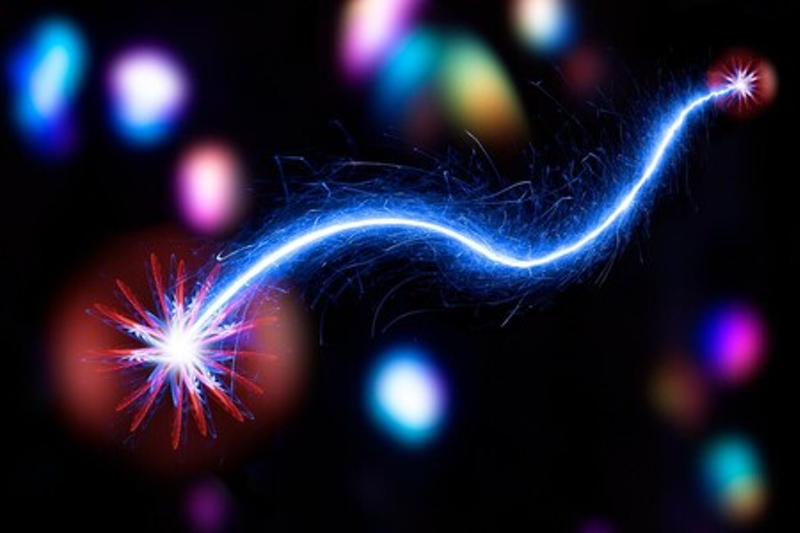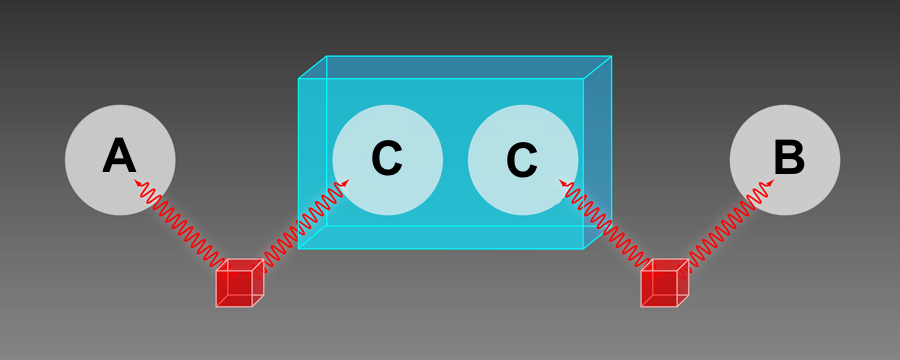About Physics
10.04.22
Michael Schirber
The 2022 Nobel Prize in Physics honors research on the foundations of quantum mechanics, which opened up the quantum information frontier.

Connected in plain view. The 2022 Nobel Prize in Physics recognizes work on measuring and controlling quantum entanglement, shown here conceptually as a link between two quantum particles. Credit: V. de Schwanberg/sciencesource.com
The Nobel Prize in Physics this year recognizes efforts to take quantum weirdness out of philosophy discussions and to place it on experimental display for all to see. The award is shared by Alain Aspect, John Clauser, and Anton Zeilinger, all of whom showed a mastery of entanglement—a quantum relationship between two particles that can exist over long distances. Using entangled photons, Clauser and Aspect performed some of the first “Bell tests,” which confirmed quantum mechanics predictions while putting to bed certain alternative theories based on classical physics. Zeilinger used some of those Bell-test techniques to demonstrate entanglement control methods that can be applied to quantum computing, quantum cryptography, and other quantum information technologies.
Since its inception, quantum mechanics has been wildly successful at predicting the outcomes of experiments. But the theory assumes that some properties of a particle are inherently uncertain—a fact that bothered many physicists, including Albert Einstein. He and his colleagues expressed their concern in a paradox they described in 1935 [1]: Imagine creating two quantum mechanically entangled particles and distributing them between two separated researchers, characters later named Alice and Bob. If Alice measures her particle, then she learns something about Bob’s particle—as if her measurement instantaneously changed the uncertainty about the state of his particle. To avoid such “spooky action at a distance,” Einstein proposed that lying underneath the quantum framework is a set of classical “hidden variables” that determine precisely how a particle will behave, rather than providing only probabilities.
The hidden variables were unmeasurable—by definition—so most physicists deemed their existence to be a philosophical issue, not an experimental one. That changed in 1964 when John Bell of the University of Wisconsin-Madison, proposed a thought experiment that could directly test the hidden variable hypothesis [2]. As in Einstein’s paradox, Alice and Bob are each sent one particle of an entangled pair. This time, however, the two researchers measure their respective particles in different ways and compare their results. Bell showed that if hidden variables exist, the experimental results would obey a mathematical inequality. However, if quantum mechanics was correct, the inequality would be violated.
Bell’s work showed how to settle the debate between quantum and classical views, but his proposed experiment assumed detector capabilities that weren’t feasible. A revised version using photons and polarizers was proposed in 1969 by Clauser, then at Columbia University, along with his colleagues [3]. Three years later, Clauser and Stuart Freedman (both at the University of California-Berkeley) succeeded in performing that experiment [4].
Bell tested. The Freedman-Clauser experiment used entangled photons from excited calcium atoms. The photons traveled to two separate polarizers, which were set at specific orientations relative to each other. The rate at which both photons went through these polarizers agreed with quantum mechanics predictions. Johan Jarnestad/Royal Swedish Academy of Sciences.
The Freedman-Clauser experiment used entangled photons obtained by exciting calcium atoms. When a calcium atom de-excites, it can emit two photons whose polarizations are aligned. The researchers installed two detectors (Alice and Bob) on opposite sides of the calcium source and measured the rate of coincidences—two photons hitting the detectors simultaneously. Each detector was equipped with a polarizer that could be rotated to an arbitrary orientation.
Freedman and Clauser showed theoretically that quantum mechanics predictions diverge strongly from hidden variable predictions when Alice and Bob’s polarizers are offset from each other by 22.5° or 67.5°. The researchers collected 200 hours of data and found that the coincidence rates violated a revamped Bell’s inequality, proving that quantum mechanics is right.
The results of the first Bell test were a blow to hidden variables, but there were “loopholes” that hidden-variable supporters could claim to rescue their theory. One of the most significant loopholes was based on the idea that the setting of Alice’s polarizer could have some influence on Bob’s polarizer or on the photons that are created at the source. Such effects could allow the elements of a hidden-variable system to “conspire” together to produce measurement outcomes that mimic quantum mechanics.
Loophole closed. For their updated Bell test, Aspect and his colleagues installed—for each of the entangled photons—a switching system that randomly changed the photon’s path between two branches. Each branch had a polarizer with a different orientation. This setup avoided the “locality loophole,” in which classical variables in the photons and polarizers could influence each other in some way to mimic quantum mechanics. Johan Jarnestad/Royal Swedish Academy of Sciences.
To close this so-called locality loophole, Aspect and his colleagues at the Institute of Optics Graduate School in France performed an updated Bell test in 1982, using an innovative method for randomly changing the polarizer orientations [5]. The system worked like a railroad switch, rapidly diverting photons between two separate “tracks,” each with a different polarizer. The changes were made as the photons were traveling from the source to the detectors, so there was not enough time for coordination between supposed hidden variables.
Zeilinger, who is now at the University of Vienna, has also worked on removing loopholes from Bell tests (see Viewpoint: Closing the Door on Einstein and Bohr’s Quantum Debate, written by Aspect). In 2017, for example, he and his collaborators devised a way to use light from distant stars as a random input for setting polarizer orientations (see Synopsis: Cosmic Test of Quantum Mechanics).

Can you repeat? The entanglement swapping developed by Zeilinger and colleagues could send entanglement over long distances. In such a quantum repeater setup, two sets of entangled photons are created (red), with one photon from each pair sent to a central station (C) where they are measured. For certain measurement outcomes, the other photons in each pair (detected at A and B) become entangled. This process doubles the distance over which entanglement can be shared, as compared with a setup having only one pair of entangled photons. APS/A. Stonebraker/D. Ehrenstein.
Zeilinger also used the techniques of entanglement control to explore practical applications, such as quantum teleportation and entanglement swapping. For the latter, he and his team showed in 1998 that they could create entanglement between two photons that were never in contact [6]. In this experiment, two sets of entangled photon pairs are generated at two separate locations. One from each pair is sent to Alice and Bob, while the other two photons are sent to a third person, Cecilia. Cecilia performs a Bell-like test on her two photons, and when she records a particular result, Alice’s photon winds up being entangled with Bob’s. This swapping could be used to send entanglement over longer distances than is currently possible with optical fibers (see Research News: The Key Device Needed for a Quantum Internet).
References
A. Einstein et al., “Can quantum-mechanical description of physical reality be considered complete?” Phys. Rev. 47, 777 (1935).
J. S. Bell, “On the Einstein Podolsky Rosen paradox,” Physics 1, 195 (1964).
J. F. Clauser et al., “Proposed experiment to test local hidden-variable theories,” Phys. Rev. Lett. 23, 880 (1969).
S. J. Freedman and J. F. Clauser, “Experimental test of local hidden-variable theories,” Phys. Rev. Lett. 28, 938 (1972).
A. Aspect et al., “Experimental test of Bell’s inequalities using time-varying analyzers,” Phys. Rev. Lett. 49, 1804 (1982).
J. W. Pan et al., “Experimental entanglement swapping: Entangling photons that never interacted,” Phys. Rev. Lett. 80, 3891 (1998).
See the full article here .
five-ways-keep-your-child-safe-school-shootings
Please help promote STEM in your local schools.
Physicists are drowning in a flood of research papers in their own fields and coping with an even larger deluge in other areas of physics. How can an active researcher stay informed about the most important developments in physics? Physics highlights a selection of papers from the Physical Review journals. In consultation with expert scientists, the editors choose these papers for their importance and/or intrinsic interest. To highlight these papers, Physics features three kinds of articles: Viewpoints are commentaries written by active researchers, who are asked to explain the results to physicists in other subfields. Focus stories are written by professional science writers in a journalistic style and are intended to be accessible to students and non-experts. Synopses are brief editor-written summaries. Physics provides a much-needed guide to the best in physics, and we welcome your comments.


